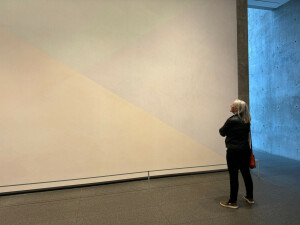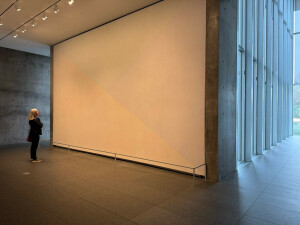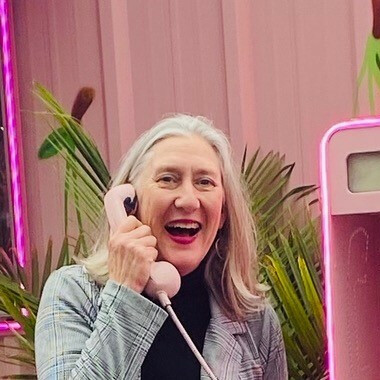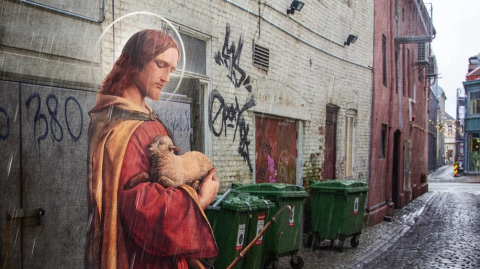TLDR: Stepping closer helps reveal what you may have missed.
Recently, I spent some time in one of my favorite cities in all of Texas... Ft. Worth, home of Joe T. Garcia’s- a Tex-Mex landmark since 1935, the historical Ft. Worth Stockyards and the Museum District featuring the Kimbell Art Museum, The Fort Worth Modern, the Amon Carter and National Cowgirl Museum and Hall of Fame, among others. Within a 72 hour window.
I had two colleagues, Eric Bumgardner and Gavin Tomlin, ordained to the priesthood at two different parishes, Trinity, Fr. Worth and St. Martin in the Fields, Keller. Bishop Jeff Fisher presided at the former and Bishop Andy Doyle at the later. During our initial preparation, all the way back in June, the day before our ordination as transitional deacons, Bishop Doyle encouraged the new clergy to support each other, just as St. Paul said in I Thessalonians 5:11, “Therefore encourage one another and build one another up, just as you are doing.”. However, I am a committed colleague and dutiful to obeying my bishop. It is not an easy trek to visit Ft. Worth twice in a three day period from this part of the Lone Star State. On the first voyage to Tarrant County, I seized the opportunity to be inspired. I got to visit not one but two of Ft. Worth’s fine museums: the Kimbell Art Museum, The Fort Worth Modern within one of my 24 hour or less visit to this fine Texas city.
At the Kimbell I visited the traveling special exhibition of Pierre Bonnard, a French post-impressionist. He is known for his use of bold colors and complex imagery- meaning in one composition I noticed, he had 2 different patterns of plaid and several other decorative designs happening harmoniously together. Although I did enjoy seeing the frothy brush strokes and flamboyant color selections, the lingering musing from this collection is not the most vivid in my recollection. Which really is a surprise because I love saturation of color.
Consequently, it was my visit to the Ft. Worth Modern I would like to share with you. One gigantic work stands out as something quite unusual. This arrangement is of Sol LeWitt (1928–2007). He was pivotal in the creation of conceptual art and had a radical even new approach to art in the 1960s. The artist had no interest in painting realistically or telling stories (like Michelangelo) in his work. He instead asserted the importance of the concept or idea. Yes, it is ‘modern art’ hence the reason it is part of the permanent collection at the Ft. Worth Modern. In fact, LeWitt’s wall drawings are executed by other people who follow his instructions. I must admit upon first impression I was not all that captivated. But upon closer inspection, I suddenly became exceedingly impressed. Remember this is about concept or theory not so much about context or story. LeWitt said in his text “Paragraphs on Conceptual Art” (1967) which was one of the first understandable proposals for “conceptual art” that challenged people into a sort of new thinking about what art could be. LeWitt wrote, “If the artist carries through his idea and makes it into visible form, then all the steps in the process are of importance. The idea itself, even if not made visual, is as much a work of art as any finished product.” He continued, “All intervening steps—scribbles, sketches, drawings, failed works, models, studies, thoughts, conversations—are of interest. Those that show the thought process of the artist are sometimes more interesting than the final product.” Honestly, I really wish I could see the more of the process of artists. I totally agree, that if we could see how the artist constructed the concept then we appreciate even more the outcome that is before us.
Here’s the larger image of when I first came across this work of LeWitt.
You can’t really tell what the image is when you see it as a whole but when you take the time to look closer and deeper, it is only then you can see that more is reveled.

Sol LeWitt, American, 1928-2007, Wall Drawing #50 A, 1970
A wall divided into four parts by lines drawn from corner to corner. Each section with three different colors made of parallel lines superimposed. Color pencil.
Drawn by: Chip Allen, Jeff Poole, and Marley Whistler,
December 2012
First installed: Midland Group Gallery, Nottingham,
England, June 1970
First drawn by: Geoff Jones
Museum Purchase, Acquired in 2010

Did I mention how large this work is?

You notice from the close-up of the composition what you cannot see from the distance. The entire composition is made with colored pencils and very, very (VERY) straight lines.
Hmmmmm. I started pondering LeWitt’s concepts for some type of spiritual application.
It hit me as I read something a parishioner sent me. Early this week I had lunch with said parishioner. She mentioned a book she was reading, How to Know a Person by David Brooks. This is his latest best seller which came out October 2023. Brooks happens to be a New York Times Opinion columnist and writes about politics, culture and the social sciences. In his chapter on The Power of Being Seen, Brooks writes,
“And all these different skills reset on one foundational skill: the ability to understand what another person is going through. There is one skill that lies at the heart of any healthy person, family, school, community organization, or society; the ability to see someone else deeply and make them feel seen- to accurately know another person, to let them feel valued, heard, and understood. That is at the heart of being a good person, the ultimate gift you can give to others and to yourself.
As I think about the Sol LeWitt composition, I consider about my early reaction, “Oh this is just another large canvas in a modern museum where some overpaid artist got the attention he was seeking.” But no, I was wrong. I did not initially see the depth of the piece. Just as I don’t always see the depth of people. This work of LeWitt, upon closer inspection, instilled within me a surge of quiet spirituality. Associating the artwork with the Brooks’ paragraph I began to ask some hard questions. How often do I look at someone and not really see them? How many times do I hear without really listening? Is it possible to gain a better understanding of others as I take the time to look closer into their hearts? Brooks states we are living in an age of creeping dehumanization and it’s time to contemplate how we can treat one another with more consideration. Oh wait... I think that’s the exact concept Jesus had in mind when He said,
“Do to others as you would have them do to you.” Luke 6:31 New Revised Standard Version.
Another version puts it this way, “And as you wish that others would do to you, do so to them.”
Okay, Mtr. Leesa, how does this relate to me? Glad you asked. So next time when you experience a trigger, you feel your emotions rising, I encourage you take a closer look. There very well could be more to the situation that what appears. Ask God to help you see beyond the obvious. Use Jesus as your example and you just might be surprised what happens when you step closer.
Rev. Leesa+





